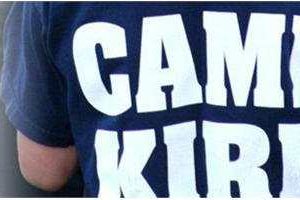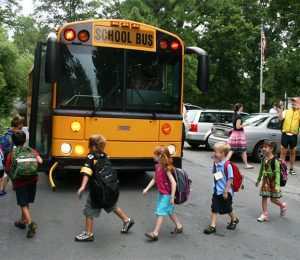Parents often think of school as the place where kids really start to learn, so it may be surprising to find out how much kids are expected to know before they even begin kindergarten!
To see if your child is prepared, ask yourself these questions:
1. Does your child have the basic day-to-day knowledge they need to function outside of their home?
2. Do they know how to be safe without a parent present?
3. Do they know how to act in a social environment?
4. Have they reached learning milestones that will make their school education easier?
If you have the slightest doubt about any of these, here is our list of things kids should know before they start kindergarten to make the transition easier.
Basic Knowledge
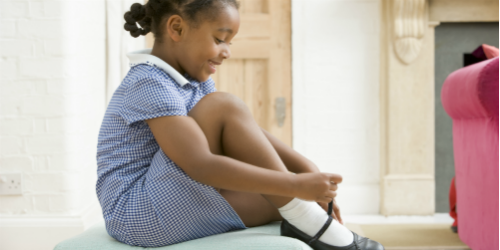
1.How to Dress Themselves
When the bell rings and a class full of kids are eager to go out to recess or head home, your child shouldn’t have to wait for the teacher to fasten their shoes or zip their jacket.
Kids should be able to put on their shoes, jacket, snow gear, and any other article of clothing they wear to school without assistance.
If zippers, buttons, and buckles prove to be difficult, opt for clothes and shoes that have Velcro and pants with an elastic waistband.
2. How to Open Lunch and Snack Containers
We all know how miserable it can be dealing with a hungry child. Imagine trying to handle a room full of them! Help out your child’s teacher by practicing with your little one how to open, close, and store all their lunch and snack gear.
If you’re looking for easy-to-use lunch containers, check out our list of the best litterless lunch boxes for back-to-school.
3. How to Blow Their Nose
When the cold and flu comes around, the last thing you want is for your child to accidentally infect their teacher and fellow classmates. Teach them how to blow their nose properly and all the other basic hygiene protocols, such as coughing into the inside of their elbow and avoiding touching others when sick.
4. How to Use the Bathroom
It is essential your child know how to be completely independent on the toilet, including wiping their own bum, since most schools do not allow their teachers to help their students in any way in the bathroom.
It is also expected that your child knows to wash their hands thoroughly after they are done on the toilet.
5. Their Full Name
When attendance is called, your child should know the difference between themselves and a classmate with the same first name.
6. How to Write Their First Name
As far as writing their name goes, your child is expected to write at least their first name so as to mark their homework. They don’t necessarily need to know how to write any other letters yet, but they should be able to write their name and recognize it on paper.
Safety Knowledge
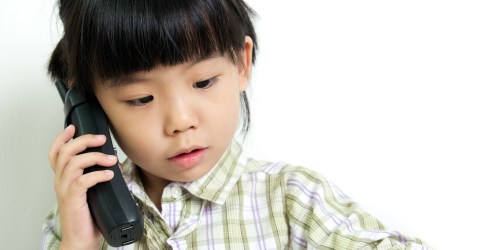
7. How to Dial 911
It’s rare that a child will need to dial 911, but it’s better that your child know how to call emergency and hope that they never need to, than have your child need to but not know how.
Make sure you tell your child when it’s appropriate and necessary to call 911; you don’t want them calling for math help like this 4-year-old did!
8. Their Address and Phone Number
In case there’s ever a miscommunication as to who is picking up your child from school, or if your child ever gets lost at a field trip, make sure they know your address and phone number so they know how to get ahold of you and find their way home.
Also, be sure they know it’s okay to ask strangers for help if they’re lost—even if your child knows their address, they likely won’t know how to get there without the help of an adult.
9. Their Allergies and Medication
Your child will be exposed to many children who do not know the potential harm of sharing food. Ensure your child knows which foods to avoid, and how to use an EpiPen if their allergy requires one.
If your child requires medication for any reason, instruct them on its use. If they have asthma they should know how to use their inhaler, and if they require daily pills they should know what time they need to take them and whether or not they should be taken with food.
10. The Dangers of Crossing Streets
Even though this knowledge is not likely to be used on school property, or even on field trips, the sooner your child knows this principle, the better.
11. What is Inappropriate Touching
Teach your child that any body part that is covered when wearing a bathing suit should never be touched by anyone, except by you or a medical professional if they need help.
As for other body parts, tell your child that how much they want to or can handle being touched is up to them. If they don’t want to be hugged or hold hands, they shouldn’t be afraid to voice that opinion.
12. How to Recognize Suspicious Behaviour
If there’s ever a creepy man hiding behind a bush near school, or if your child sees a person in a white van asking kids to come in for candy, they should recognize that they need to inform an adult of authority immediately.
Social Skills

photo: Poughkeepsie Day School/Flickr CC
13. How to Share
Toys, books, and craft supplies are limited in the classroom. Twenty kids and five pairs of safety scissors doesn’t add up! Teach your child that patience is a virtue and all good things will come in due time.
14. The Importance of Listening
It can be extremely frustrating for a teacher to hold the attention of so many kids at once. In order for the classroom to be a productive place of learning, the teacher needs the cooperation of the students. Let your child be an example to their classmates on how to behave during learning time.
15. Manners
Give your child the best chance of making friends by teaching them how to be polite to their classmates. Teaching them manners is also important for student-teacher interaction, since it’s natural to have more patience for teaching and explaining if the student is respectful.
16. How to Respect Authority
Being polite and listening to the teacher can go a long way in the classroom, but respecting them as an authority figure goes further. Your child should know and accept that the teacher, principal, librarian, etc. is older and knows more, and that doing as they instruct is important, either for learning or for their safety.
17. How to Handle Failure
The point of school is for your child to learn things they don’t already know. Progress requires a learning curve, and mistakes will happen.
When learning to read, your child will regularly mispronounce words or come across something they don’t understand. They need to know that it’s okay to not be perfect and that mistakes aren’t failures, as long as they did their best.
Rosie Revere, Engineer is an excellent children’s book that teaches the lesson that mistakes are actually a good thing, because they help us learn!
18. How to Solve Problems without Aggression
Your child may be a harmless sweetheart who cares about and loves everybody, but the urge to lash out when angry is human nature. Take the time to teach your child that when a classmate grabs a toy they’re using, getting the teacher rather than hitting the classmate is best.
Simply telling your child “hurting people is bad” may be not enough of an explanation. If your child still acts out with violence, try explaining that they’ll have an easier time making (and keeping) friends and avoiding punishment if they use words instead of violence.
Building Blocks for School Learning
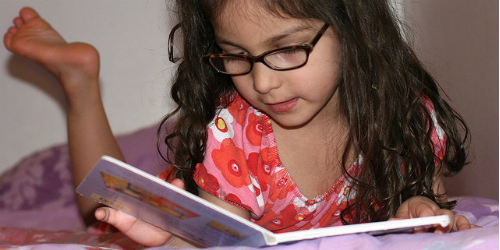
photo: Alec Couros/Flickr CC
19. The Alphabet
In order to start learning how to read and write, knowing all the letters of the alphabet is going to greatly help your child in the classroom.
They don’t need to know how to write the alphabet (other than the letters for their first name), but just knowing the alphabet song will be enough of a starting point when going into kindergarten. If your child can look at individual letters and recognize what they are, even better!
20. How to Count to 10
It takes a long time to build up the knowledge needed to learn calculus in high school, so teaching the basics of math starts as soon as possible in kindergarten. First things first: your child needs to know their numbers!
Before starting kindergarten, your child should be able to count to 10 at the very least, although The Measured Mom says children who can’t count to at least 29 are behind.
Other than just counting by rote, your child should know that counting represents a quantity. For example, they should be able to accurately answer quantity-based questions, such as “How many apples do you see?”
Just like with the alphabet, your child doesn’t need to know how to write the numbers. But recognizing individual numbers will put them ahead of the game.
21. The Concepts of Less and More
Knowing the concepts of “less” and “more” is an important building block for learning addition and subtraction.
It is not yet essential that your child make the connection that 3 is less than 4, but what is important is knowing that if you have 4 apples and take one away, there are now fewer apples than there were before. Likewise: this ball is bigger than that ball, the cat is heavier than the hamster, and so on.
22. Basic Colours and Shapes
Knowing colours and shapes is important because it leads to kids being able to classify and organize the world around them. Knowing “this circle is blue” and “this circle is red” is the easiest and earliest system of classification, which opens the way for learning bigger differences later, such as how one definition of a word is different from another.
Former Grade 1 teacher Jenae at I Can Teach My Child says that before entering kindergarten, your child should know at least 10 basic colours (red, yellow, blue, green, orange, purple, black, white, brown, and pink) and 4 basic shapes (circle, square, rectangle, and triangle).
23. The Proper Way to Read a Book
Your child won’t learn how to read a book if they’re holding it upside down! By the time they start kindergarten kids should know which edge of a book is up and which is down, which side is the front and which is the back, and that when reading we go from left to right across the page.
They may have no clue what they’re looking at, but at least they can follow along during storytelling and make connections between the spoken words and the letters on the page.
24. How to Follow 2- to 3-Step Instructions
When managing 20 students at once, the teacher doesn’t have the time to repeat herself to every single student. When explaining an activity to the class, the teacher will often give two or three steps at a time, and then they will walk around the class helping individual students who need it before giving the next two or three steps.
If your child can be told “Grab a blue paper and a red paper, cut a circle out of the blue paper, then glue the blue circle onto the red paper” and follow the instructions without being reminded of the steps, mission accomplished!
PHOTO: WOODLEYWONDERWORKS/FLICKR CC
READ MORE LIKE THIS:
If your little one got a little too comfortable with not being in school, try these 10 back-to-school preperation tips to help them get back into the swing of things.
Here’s a helpful back-to-school checklist for parentsto take some of the the sting out of prepping for back to school this fall!
Ease some of your anxieties about your child’s first day of kindergarten with this guide on how to prepare your child for the first day of kindergarten.
Sign up for our newsletters to get parenting and family fun articles delivered to you!



